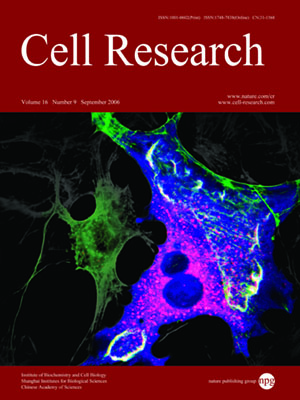
Volume 16, No 9, Sep 2006
ISSN: 1001-0602
EISSN: 1748-7838 2018
impact factor 17.848*
(Clarivate Analytics, 2019)
Volume 16 Issue 9, September 2006: 750-758
ORIGINAL ARTICLES
Coordinated peak expression of MMP-26 and TIMP-4 in preinvasive human prostate tumor
Seakwoo Lee, Kevin K Desai, Kenneth A Iczkowski, Robert G Newcomer, Kevin J Wu, Yun-Ge Zhao, Winston W Tan, Mark D Roycik, Qing-Xiang Amy Sang
1Department of Chemistry and Biochemistry and Institute of Molecular Biophysics, Florida State University, Tallahassee, FL 32306,
USA; 2Department of Pathology and Laboratory Medicine, Veterans Affairs Medical Center, Gainesville, FL 32608, USA; 3Department
of Pathology, Immunology, and Laboratory of Medicine, University of Florida College of Medicine, Gainesville, FL 32610,
USA; 4Department of Pathology, Medicine, Mayo Clinic, Jacksonville, FL 32224, USA; 5Department of Internal Medicine, Hematology/
Oncology, Mayo Clinic, Jacksonville, FL 32224, USA
Correspondence: Qing-Xiang Amy Sang(sang@chem.fsu.edu)
The identification of novel biomarkers for early prostate cancer diagnosis is highly important because early detection and treatment are critical for the medical management of patients. Disruption in the continuity of both the basal cell layer and basement membrane is essential for the progression of high-grade prostatic intraepithelial neoplasia (HGPIN) to invasive adenocarcinoma in human prostate. The molecules involved in the conversion to an invasive phenotype are the subject of intense scrutiny. We have previously reported that matrix metalloproteinase-26 (MMP-26) promotes the invasion of human prostate cancer cells via the cleavage of basement membrane proteins and by activating the zymogen form of MMP-9. Furthermore, we have found that tissue inhibitor of metalloproteinases-4 (TIMP-4) is the most potent endogenous inhibitor of MMP-26. Here we demonstrate higher (p<0.0001) MMP-26 and TIMP-4 expression in HGPIN and cancer, compared to non-neoplastic acini. Their expression levels are highest in HGPIN, but decline in invasive cancer (p<0.001 for each) in the same tissues. Immunohistochemical staining of serial prostate cancer tissue sections suggests colocalization of MMP-26 and TIMP-4. The present study indicates that MMP-26 and TIMP-4 may play an integral role during the conversion of HGPIN to invasive cancer and may also serve as markers for early prostate cancer diagnosis.
Cell Research (2006) 16:750-758. doi: 10.1038/sj.cr.7310089; published online 29 Aug 2006
FULL TEXT | PDF
Browse 1761


